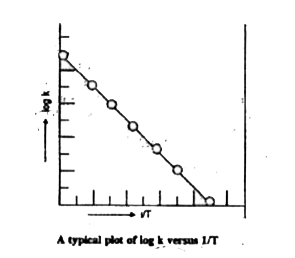How is rate constant of a reaction related to its activation energy?Solution in Punjabi
Arrhenius (1889) developed a mathematical relationship between temperature and the rate constant on the basis of the observations from the large number of experiments. The temperature dependence of the rate constant, k is expressed algebraically as follows.
k∝e−Ea/RT
k=Ae−Ea/RT

This equation is known as Arrhenius equation. Here, A is a constant of proportionality and is known as frequency factor:-This-factor is related to the number of binary molecular collisions per second per litre. E is the activation energy, R is gas constant and T is the absolute temperature. Taking logarithm, egn. (1) may be written as ,
In k=In A+ In e−Ea/RT
In k=In A-EaRTIne
In k=InA−EaRT [∵In e=1] ...(ii)
Converting to common logarithm, we get
logk=logA−Ea2.303R1T ... (iii)
or logk=−Ea2.303R1T+logA
This equation is of the form y = mx + ci.e., the equation of a straight line. Thus, if a plot of log k versús 1/T is a straight line, the valdity of the equation is confirmed. From eqn: (lin) we havė,
Slope of the line = Ea2.303R
Thus, by knowing the value of the slope and gas constant R, the activation energy E can be calculated.
Alternatively, Ea, can be determined by using another form of the Arrhenius equation in which A is eliminated. This is because frequency factor A cannot be determined accurately for the reactions. From eqn. (iii)
In k=In A-EaRT
In k = In k1 and k2 are the values of rate constants at temperatures T1 and T2, then,
In k1=InA−EaRT1 ...(iv)
and Ink2=InA−EaRT2
In Subtracting eqn. (iv) from egn. (v), we get
In k2-In k1=−EaRT2−−EaRT1
In k2−Ink1=EaRT1−EaRT2
In k2k1=Ea2.303R[T2−T1T1T2]
Converting to common iogarithm,
log k2k1=Ea2.303R[T2−T1T1T2]
Topper's Solved these Questions
- BOOK - BETTER CHOICE PUBLICATIONCHAPTER - CHEMICAL KINETICSEXERCISE - Numerical Problems63videos
CHEMICAL KINETICS
- BOOK - BETTER CHOICE PUBLICATIONCHAPTER - BIOMOLECULES EXERCISE - QUESTION BANK85videos
BIOMOLECULES
- BOOK - BETTER CHOICE PUBLICATIONCHAPTER - CHEMISTRY IN EVERYDAY LIFEEXERCISE - QUESTIONS76videos
CHEMISTRY IN EVERYDAY LIFE
Similar Questions
The rate constant of a reaction is 1.5×107sec−1 at 50∘C and 4.5×107sec−1 at 100∘C. Calculate energy of the activation for the reaction.
01:03View SolutionCovalent compounds are soluble in
02:41View SolutionWhat is a medicine ?
01:51View SolutionThe activation energy of a reaction is zero. The rate constant of this reaction
03:03View SolutionWhat is the relation between rate constant and activation energy of a reaction?
01:03View Solutionwhat is the activation energy? How is rate constant related to activation energy?
02:09View SolutionHow is rate constant of a reaction affected by temperature ? Write the name of this relation. How will you calculate activation energy of a reaction with the help of this relation ?
01:41View SolutionThe activation energy of a reaction is zero. The rate constant of this reaction
01:41View SolutionThe activation energy of a reaction is zero . The rate constant of the reaction :
01:54View Solutionएक अभिक्रिया की सक्रियण ऊर्जा शून्य है। इस अभिक्रिया के लिए दर स्थिरांक
01:51View Solutionएक अभिक्रिया की सक्रियण ऊर्जा शून्य है। इस अभिक्रिया के लिए दर स्थिरांक
03:18View SolutionThe activation energy of a reaction is zero. The rate constant of this reaction
View SolutionWhat is the relation between rate constant and activation energy of a reaction?
03:05View SolutionHow is energy of activation related to rate constant of a reaction?
02:41View SolutionHow is energy of activation related to rate constant of a reaction ?
01:37View SolutionThe activation energy of a reaction is zero. The rate constant of this reaction
View Solution

